If you’ve been growing your email list for your online business, you know how effective email marketing can be.
Now you’re probably asking: how can I continue to be effective with my email marketing?
To help answer that question, I’ve compiled a list of email marketing best practices that I encourage you to incorporate into your email marketing efforts in 2020 and beyond.
%(tableofcontents)
What Is The State Of Email Marketing In 2020?
Before we dive into these best practices, consider the following statistics:
-
The number of mobile internet users is expected to reach 5 billion by 2025. For context, this represents more than 60% of the world’s population.[*]
-
95% of consumers check their personal email every day. If your message reaches their inbox, there’s a high probability they’re going to see it.[*]
-
81% of small businesses rely on email as their primary online customer acquisition channel.[*]
From these statistics, we can safely conclude email isn’t going away. As the global market of consumers that have access to email continues to grow, more and more businesses stand to benefit from learning how to grow, nurture, and profit from their email list.
With these stats in mind, here are some best practices you can incorporate into your email marketing to help ensure your emails are relevant to your subscribers, generate engagement, and, ultimately, drive more sales of your products and services.
1. Start With Compelling Subject Lines
According to a report by MailChimp, the average open rate on emails across more than 40 industries in 2019 was 21.33%. One of the main contributors to your open rates are your subject lines.[*]
Here are a few tips to help you write compelling subject lines:
USE SHORT SUBJECT LINES
Keep your subject lines short (4-7 words is ideal) and avoid using all caps. Longer subject lines typically get cut off on mobile devices, and excessive use of caps can be perceived as rude and intrusive.
If you need some inspiration, check out this list of 80 best email subject lines.
GENERATE CURIOSITY
Instead of explicitly stating the content of your email, use words that create curiosity (without being misleading). Remember, the goal of a subject line is to get someone to open the email, and curiosity helps with this.
Direct response copywriter Daniel Doan does a great job with his subject lines. Most of his subject lines contain eight words or fewer, and are written to generate enough curiosity to open the email:

USE EMOJIS
Experian found 56% of brands using emojis in their subject lines experienced higher open rates. Evidently, using emojis is a great way to help your subject lines stand out in a crowded inbox, convey a specific emotion, and humanize your brand.[*]
Depending on your industry and target audience, using emojis could be perceived as unprofessional or off-brand. Assuming they’re not, I recommend trying them — just don’t overdo it.
Here’s the subject line of an email SquadCast (a podcast recording software) sent, announcing an upcoming change to their pricing. This emoji helped them convey the emotion a customer may feel, without using a lot of extra words:

PERSONALIZATION
Emails that include the first name of the recipient in their subject line have higher open rates and click-through rates than those that don’t. That said, adding your subscriber’s name to your subject line isn’t the only way to personalize an email.[*]
If you have other information about your subscriber (such as their location, industry, interests, etc.), you can personalize your subject line even more by including that information.
Here’s the subject line of an email I received from Mikael Dia (Founder of Funnelytics), which included my first name and the type of business owner the email is intended for:

SPLIT TESTING
Many email service providers allow you to split test different versions of your subject line. With Mailchimp, for example, you can test multiple subject lines on a specific percentage of your list then have the winning subject line sent to the rest of your list after the test is complete.
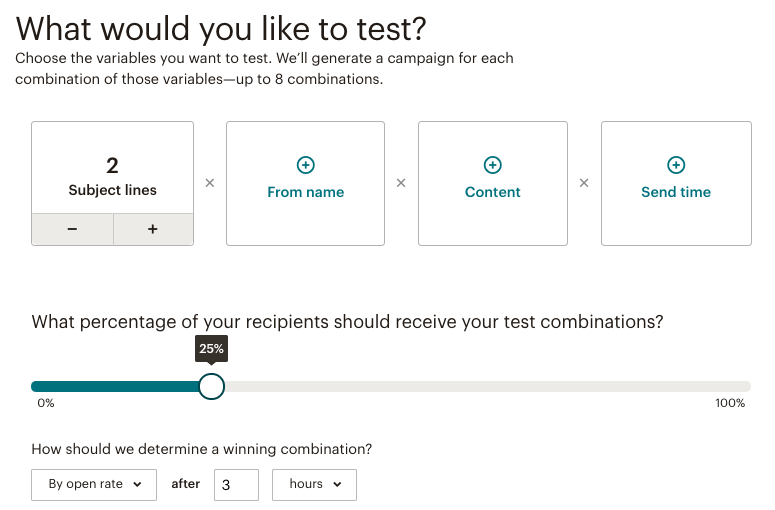
2. Add Preheader Snippets
Your preheader snippet is the small line of text that appears after the subject line in an email inbox:
![]()
By default, most inboxes will display the first few lines of text in your email as your preheader snippet. Since this doesn’t always work in your favor, it’s better to write a customized preheader snippet for your emails.
Sumo email editor lets you customize the preheader snippet here:
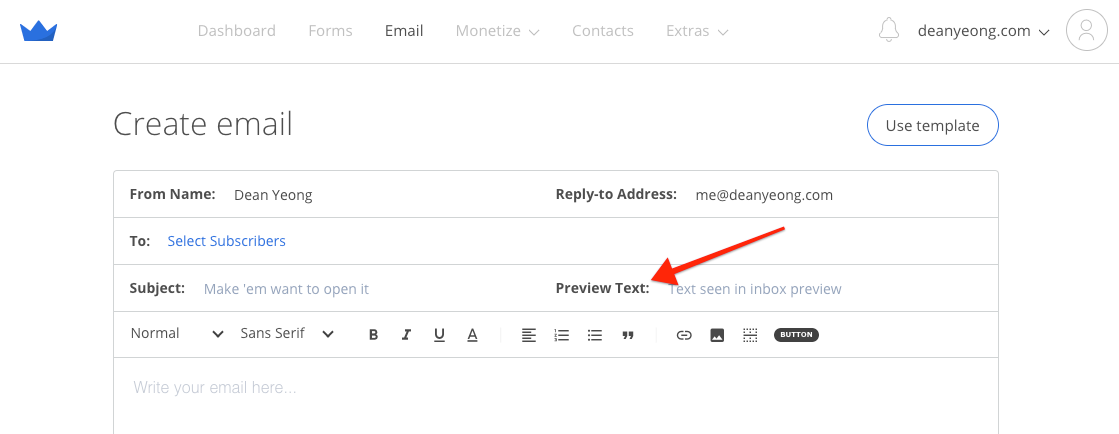
Here are a few tips for writing effective preheader snippets:
-
Don’t repeat the subject line
-
Keep it short (30 – 50 characters) to help prevent the text from getting cut off
-
Don’t summarize your email
-
Add a CTA to help encourage the recipient to open the email
3. Send Only Relevant Content
Email marketing is one of the most effective (and least expensive) ways to share your content, so it's no surprise that 87% of B2B content marketers use email to distribute their content. With the competition for your market’s attention so high, most consumers have a dwindling tolerance for content that isn’t relevant to them.[*]
Here are some ways to ensure your emails are relevant to your subscribers:
SHARE CONTENT TAILORED TO YOUR SUBSCRIBERS' INTERESTS
Don’t assume everyone on your email list has the same interests. Whenever possible, segment your subscribers by their interests and then only send messages relevant to those interests.
INCLUDE CTAS APPROPRIATE FOR THE SUBSCRIBER'S CURRENT STAGE IN YOUR FUNNEL
Avoid including CTAs that don’t move someone forward in your marketing funnel. If you have multiple funnels (for different products and services), be very intentional about which segments of your email list you promote other products or services to.
If someone recently downloaded a free case study and the next thing you want them to do is to schedule a consultation, don’t include a CTA to consume more content or download other free resources. Move them forward in your funnel, not backward.
SEND CUSTOM EMAILS TRIGGERED BY SPECIFIC BEHAVIOR
Instead of assuming a subscriber has taken a specific action, create tags to identify which of your subscribers have taken specific actions.
Here’s an example of an automation based on subscriber behavior that I created using ActiveCampaign:

When someone opts in to receive my free Content Marketing Worksheet, they automatically receive an email with the link to download the worksheet. If they click the link in the email, they are tagged as having clicked the link.
Six hours later, ActiveCampaign checks to see if that subscriber has the link click tag. If they don’t, they are sent a reminder email to download the worksheet before receiving the next email in my follow-up sequence:
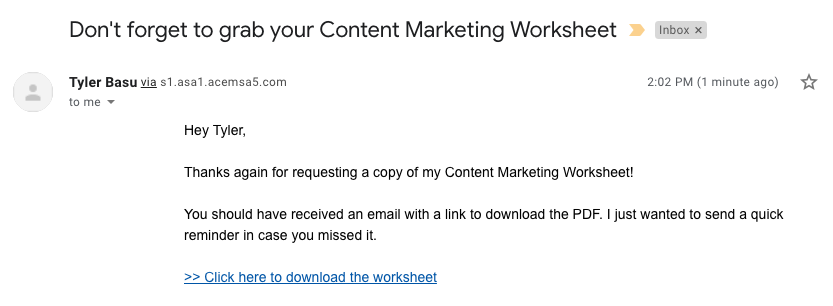
4. Segment Your Email List
One of the biggest mistakes you can make as an email marketer is to treat everyone on your list equally. To help ensure your subscribers receive relevant emails based on their interests or stage in your marketing funnel, you’ll need to segment your list.
Segmentation enables you to send the right message, to the right person, at the right time. And the extra effort that it takes to segment your email list is definitely worth it. Segmented email campaigns contribute to higher open rates, higher click-through-rates, lower bounce rates, and lower unsubscribe rates.[*]
To give you an example, I recently wanted to email my subscribers who watched my webinar but had not applied for a free consultation (the goal of the webinar was to produce free consultations). By creating a segment of my list for the email, I was able to send a follow-up message to these subscribers:

Segmenting your subscribers based on website pages they’ve visited (or not visited) is just one of several ways to divide your list.
Here are four ways most email service providers will allow you to create a segment of your list before sending an email:
-
Demographics (age, gender, industry, occupation, etc.)
-
Location (city, state, country, etc.)
-
Interests (content consumed, survey responses, etc.)
-
Behavior (pages visited, links clicked, purchases made, etc.)
5. Optimize Your Welcome Email
The first email you send to a new subscriber is probably the most important email you will ever send to your list. Your welcome email is the beginning of what is hopefully a long-term and profitable relationship with your subscriber.
With an average open rate as high as 82%, your welcome email is likely to have a higher open rate than all of your future marketing emails. For that reason alone, it’s important to be extremely intentional about what you include in that email.[*]
Here are a few tips to help you write a great welcome email:
SET EXPECTATIONS
For new subscribers to your list, reintroduce yourself or your business. Remind them why they joined your list and let them know what they can expect from future emails (such as email types and frequency).
Here’s an example of a well-written welcome email I received from Eric Siu (CEO of Single Grain), immediately after opting in to receive one of his free resources. What I like most about this welcome message is that it allows me to segment myself based on my current stage in business, which will help to tailor future emails that are sent to me.
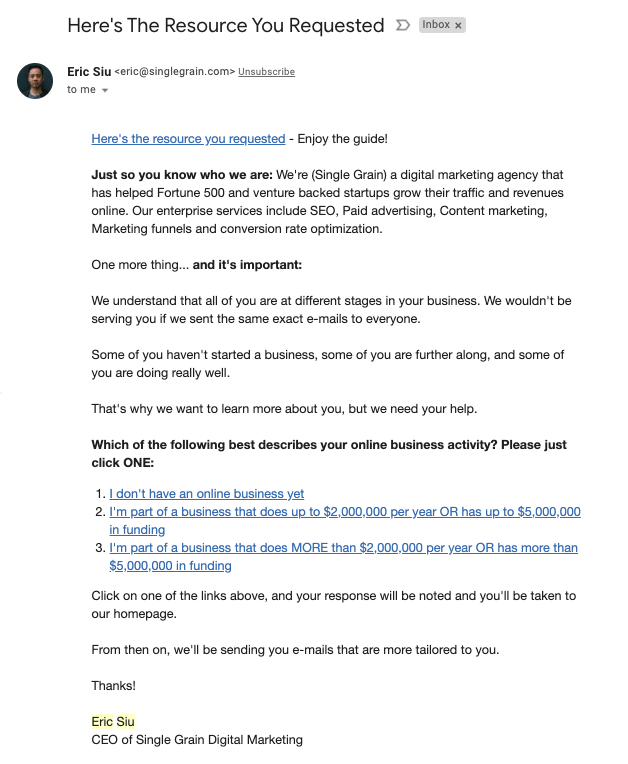
OPEN A LOOP
If you have additional emails in your welcome sequence, build anticipation for those emails by letting your subscriber know what you’ll be sending them next (more tips, special offers, etc.).
Here’s an example of how I opened a loop at the end of an email in one of my email sequences:

ASK FOR A REPLY
If they subscribed to your email by requesting a specific resource, ask them to confirm that they received the resource. If you’d like to start a conversation with your subscriber, ask them a specific question and tell them to reply with their response.
6. Subscriber Control and List Maintenance
Many marketers give their subscribers one of two options: stay subscribed to their list and receive all of their emails or unsubscribe and receive no emails at all.
Giving your subscribers more control over the emails they receive from you, combined with the regular removal of inactive subscribers (list maintenance), helps maintain higher open rates and a better reputation with your email service provider.
Depending on your email service provider, you may be limited in the number of things you can give your subscribers control over. If possible, here are two things to consider giving your subscribers control of:
Control over types of emails received
Not all of your subscribers will want to receive every type of email that you send. Give them the ability to subscribe and unsubscribe from specific types of emails (new content, promotions, product updates, customer-only emails, etc.).
Here’s an example of a note in a promotional email for an online course. By clicking the link in the P.S. section of the email, I would stop receiving emails about the course but remain subscribed to their list.

This simple technique allowed the sender to segment their email list based on a subscriber's interest in a specific course, without forcing those who are not interested to unsubscribe from their list.
Control over sending frequency
Let your subscribers choose how often they will receive email communication from you (weekly, biweekly, monthly, etc.). A significant portion of your list will likely want to continue receiving emails from you, but less frequently.
LIST MAINTENANCE
Another way to help maintain an engaged list of email subscribers is to conduct regular list maintenance. Here are some things you can do on a quarterly (or even a monthly) basis:
Check in with inactive subscribers
Create a segment of your list that has not opened or engaged with any of your emails for a specific period of time, and then send them an email to ask if they still want to continue receiving email communication from you.
Here’s an example of an email I received from Taylor Welch (Co-Founder of Traffic And Funnels) after not opening any of their emails for a few weeks, asking me to confirm that I want to stay subscribed to their list:

Remove inactive subscribers
Regularly removing inactive subscribers from your list is a great way to help maintain healthy open rates on your emails. Since some email service providers charge based on list size, pruning your list of inactive subscribers can also help reduce your costs, too.
7. Split Test Regularly
Conducting split tests with your emails is a great way to gather data on what works best for your email list and/or specific segments of your list.
In addition to your subject lines, here are a few other things you can test to help you increase the open rates and click-through rates of your emails:
CALL TO ACTION
Test different CTAs in your emails, as well as different CTAs for specific segments of your email list.
DESIGN
Try different design templates, layouts, fonts, colors, text sizes, etc. to see which design gets you the best results.
SEND TIMES
Test different sending times for your emails, as well as sending emails based on your subscriber’s local timezone (most email service providers allow you to do this).
Here’s an example of a split test I set up using ActiveCampaign. In this case, I created two different versions of an email. Each version will be sent to 15% of my list. After one day, the winner (the email with the highest open rate) will be sent to the remaining 70% of my list:
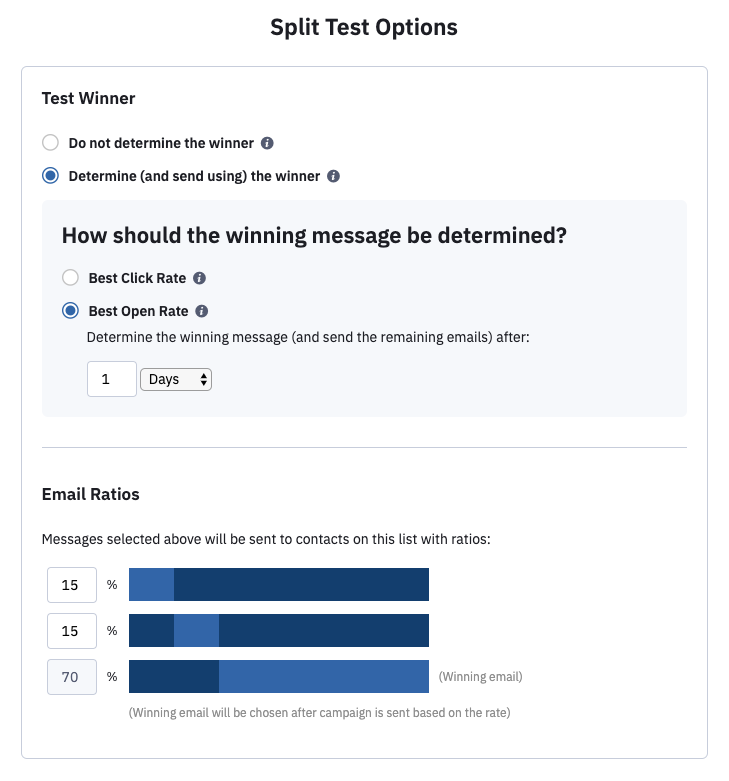
8. Stay Compliant
Fundamentally, email marketing is meant to be a permission-based medium of communication. For the sake of building a sustainable business where our subscribers and customers want to hear from us, let’s abide by email marketing regulations and best practices.
Here are a few tips to avoid spam complaints from your subscribers:
DOUBLE OPT-INS
Don’t allow new subscribers to join your email list without first confirming that they would like to receive email communication from you. This can be accomplished using a double opt-in, where your email service provider sends a confirmation email to a new subscriber before sending your first marketing email, like this one:
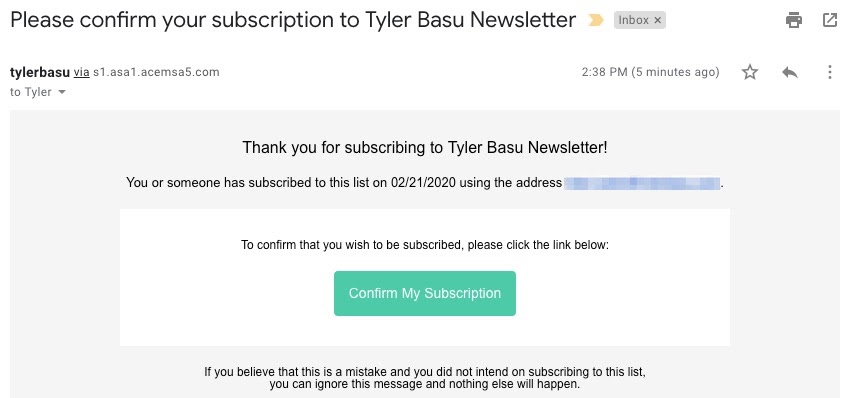
GDPR COMPLIANCE
GDPR is the overall name given to a series of EU laws around personal data protection, including the collection and use of email addresses. These laws don’t just apply to organizations based in the EU, but to anyone who stores and processes data on an EU citizen.
Without going into too much detail (check out this guide to GDPR and email marketing for more details), the bottom line is that we need to be able to show that our subscribers have given us their consent to send them marketing emails.
UNSUBSCRIBE LINKS
Don’t make your subscribers have to work to unsubscribe. Include an easy-to-find unsubscribe link in the header or the footer of all of your emails — like this link in a footer, for example:

9. Invest In Becoming Mobile-Friendly
With nearly half of all emails opened on a mobile device, your emails must be optimized for mobile.[*]
Here are a few tips for sending mobile-friendly emails:
MOBILE-RESPONSIVE DESIGN
For emails that are not plain text, use a mobile-responsive design that adapts to varying screen sizes.
PARAGRAPH SIZE
Don’t write long paragraphs. Break up long paragraphs into smaller sections, so there is plenty of white space throughout your email.
EMAIL LENGTH
As a general rule, it’s best to keep your emails short and to the point. According to an analysis of more than 40 million emails, the highest response rates were attributed to emails that contained between 50-125 words. [*]
IMAGE SIZE
Avoid using large image sizes that take longer to load. Most email service providers allow you to change the resolution of an image after you’ve uploaded the original image file but not the image file size. The most popular screen resolution worldwide (across all platforms, including mobile) is 360×640.[*]
I also recommend you avoid using images that may not be legible on a small device (infographics with small text, for example).
10. Stay Consistent
A never-ending debate among marketers is how often to send emails to our list. Some marketers email their list daily and claim that this works well for them, while others hesitate to send more than 1-2 emails a month.
One thing we can all agree on, however, is that consistency matters. To stay top-of-mind with your subscribers, you’ll need to communicate with them consistently.
How often you email your list is entirely up to you. There isn’t a one-size-fits-all frequency that works best for every business. The best way to determine how often you should send to your list is to test different frequencies and gauge the effect it has on your goals (open rates, unsubscribes, sales, etc.).
Regardless of how often you email your list, remember to focus on quality over quantity. Email your subscribers when you have someone relevant and/valuable to share with them. Don’t just email your list for the sake of emailing them.
Justin Brooke (Founder of AdSkills), for example, emails his subscribers daily. This may seem excessive to some, but thanks to a thoughtful blend of engaging stories, educational content, and occasional special offers, his email list continues to be a primary driver of website traffic and revenue for his company.
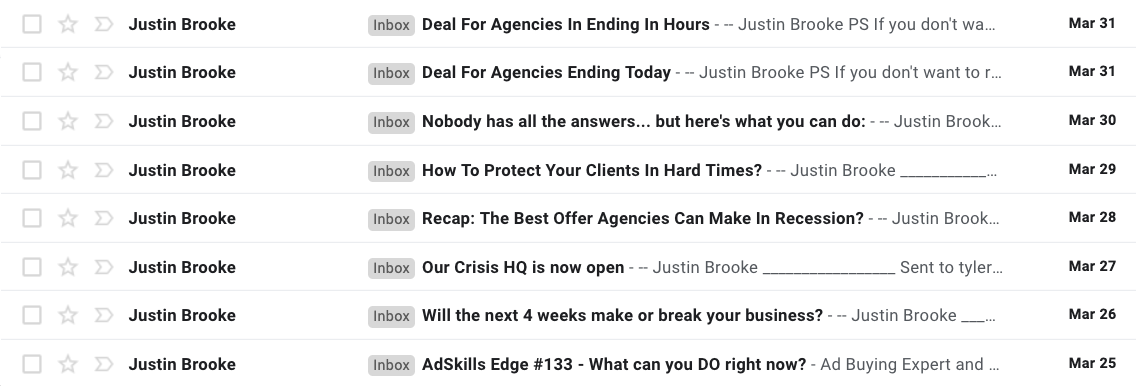
In the 15+ years that I’ve been sending emails I’ve tried weekly, daily, twice daily, and twice weekly. The more emails I send the more money I make, but then there’s also a churn rate. Daily is best for revenue, but twice weekly is best for list growth. You just have to decide what season you are in at the moment. But even slower paced emails full of value will still have a churn rate so don’t sweat the unsubscribes too much. – Justin Brooke, AdSkills
Follow These Best Practices For Better Email Marketing Results In 2020 & Beyond
Even though it can be exciting to explore new strategies, tactics, and platforms to promote our business, email marketing is still one of the most effective marketing channels available to marketers today.
A key factor in email marketing’s effectiveness is consumers want to hear from brands via email. 72% of consumers prefer that businesses communicate with them via email.[*]
That said, to continue building your list and using email marketing to help drive more revenue for your business, you’ll need to adapt your email marketing strategy based on best practices and regulations.
As a quick review, here are best practices to follow in 2020 and beyond:
And remember that there is no one-size-fits-all email marketing strategy that works best for every business. As a marketer, you have a responsibility to rely on data that reveals what works best for your target audience and your business.
Follow the best practices outlined in this article, be willing to test your assumptions and new techniques regularly, and let the results of your tests guide your decisions.
Add A Comment
VIEW THE COMMENTS